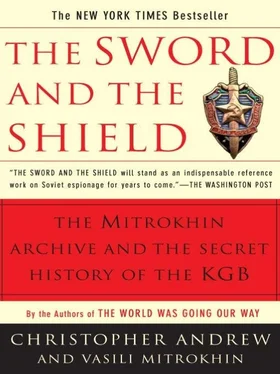The most influential of those critics was, increasingly, Andrei Sakharov. From the KGB’s viewpoint, both the importance and the difficulty of discrediting Sakharov before world opinion were heightened by his being awarded the Nobel Peace Prize in October 1975. The Oslo residency had been instructed to do all in its power to prevent the award, but was forced to confess that it was powerless to influence the Nobel Peace Prize committee which, it claimed, was wholly composed of “reactionaries”—chief amongst them its chairwoman, the Labor Party deputy Aase Lionaes. 2Sakharov pronounced the Peace Prize “a great honor not just for me but also for the whole human rights movement”:
I feel I share this honor with our prisoners of conscience—they have sacrificed their most precious possession, their liberty, in defending others by open and non-violent means. 3
Just over a week after he received news of the award, the first of the “Sakharov Hearings,” held in response to an appeal launched by Sakharov and other dissidents a year earlier, opened in Copenhagen to hear evidence of Soviet human rights abuses—almost all of them in breach of the Helsinki Accords.
On November 22 Andropov approved a document entitled “Complex Operational Measures to Expose the Political Background to the Award of the Nobel Peace Prize to Sakharov.” The sheer range and ambitiousness of the active measures proposed indicated Sakharov’s increasing prominence as a KGB target. In collaboration, where necessary, with other KGB directorates, the FCD was instructed:
• to inspire articles and speeches by public and political personalities in Norway, Finland, Sweden, Denmark, Britain and the FRG, to develop the theme that the award of the Nobel Peace Prize to Sakharov was an attempt by certain political circles to slow down the process of détente…
• to organize articles and speeches by representatives of public and political circles through KGB assets in Finland, France, Italy and Britain, to demonstrate the absurdity of attempting to link the award of the Peace Prize to Sakharov to a decision relating to the all-European [Helsinki] Conference…
• to organize the mailing of letters and declarations protesting about the award of the Peace Prize to Sakharov to the Nobel Committee of the Norwegian Storting [parliament] and to influential press organs in various Western countries…
• to pass material compromising Sakharov to the Danish, Swedish and Finnish press, hinting at his links with reactionary organizations financed by the CIA and other Western special services;
• to take steps designed to persuade S. Haffner, the leading political observer of the West German Stern magazine to make negative comments on the award of the Nobel Peace Prize to Sakharov. Haffner had already made sharp criticisms in the FRG press when Sakharov was put forward for the Peace Prize in 1973;
• to pass information to the “dissident” emigration in western Europe designed to exacerbate relations between Sakharov and Solzhenitsyn…
• with the help of agents of influence among prominent Chilean émigrés (in Algeria and Mexico), to disseminate the text of a [bogus] telegram of congratulations supposedly sent by General Pinochet [who had led the coup against President Allende] to Sakharov on the occasion of the award of the Nobel Peace Prize;
• to inspire pronouncements by leading Chilean émigrés in Italy, the FRG and France, expressing the outrage of all Chilean patriots at the award of the Nobel Peace Prize to Sakharov, who in 1973 had welcomed the overthrow of the Allende government and in return for this had been awarded the title of “Honorary Citizen” by Pinochet;
• to inspire public statements by public personalities in the Arab countries, condemning the Nobel Committee’s decision on Sakharov, presenting this as a deal between Sakharov and the Zionists, in return for Sakharov’s pronouncements on the question of Jewish emigration from the Soviet Union, as the Zionists had a decisive influence on the Nobel Committee when it awarded the Nobel Peace Prize for 1975. It should be noted that the “Sakharov Hearings” in Copenhagen were also a form of payment to Sakharov by the Zionists in return for his pro-Israel activity;
• to make available through Novosti for publication abroad a series entitled “Who Defends Sakharov?,” dealing with [alleged pro-Sakharov] criminals sentenced in the Soviet Union for bribery (Shtern), theft (Leviyev), instigation of terrorism (Bukovsky, Moroz). 4
The main fabrications intended to discredit Sakharov personally—his links with Western intelligence agencies, his support for the Pinochet regime and his plots with the Zionists—were all further developed in active measures over the next few years. 5The files examined by Mitrokhin, however, record few immediate successes for the operations approved by Andropov in November 1975. The best the Oslo residency could do to provoke Norwegian opposition to Sakharov’s award was to claim the credit for an article submitted to Dagbladet ridiculing his wife Elena Bonner, who in December 1975 collected the award in place of Sakharov after he was denied an exit visa. The article [which seems not to have been published] claimed that Bonner, a heavy smoker, was constantly providing “free publicity for the tobacco industry” and should have received a cigarette lighter rather than the Nobel Prize. 6
In Oslo to see Bonner collect the award on behalf of Sakharov was the Soviet émigré Vladimir Maximov, editor-in-chief of the journal Kontinent, which published news of dissidents throughout eastern Europe in Russian, English, French, German and Italian editions. The first issue in September 1974 had opened with a ringing declaration by Solzhenitsyn:
The intelligentsia of eastern Europe speaks with the united voice of suffering and knowledge. All honor to Kontinent if it is able to make his voice heard. Woe (which will not be long in coming) to western Europe if its ears fail to hear. 7
Kontinent rapidly established Maksimov as second only to Solzhenitsyn in the KGB’s list of émigrées enemies. Among the most ingenious of the many active measures used to discredit him in 1976 was one which followed the discovery that a car used by Eduard Mihailovich Serdinov (codenamed TKACHEV), an operations officer in the New York residency, had been bugged by the FBI. It was decided to stage a conversation in the car between Serdinov and a KGB agent from the Soviet community which, it was hoped, would deceive the FBI:
SERDINOV: By the way, Solzhenitsyn’s chum Maksimov is also becoming more and more insolent. He is turning into an open enemy.
AGENT: Which Maksimov do you mean?
SERDINOV: That Parisian one—from the Kontinent.
AGENT: Oh, don’t pay any attention to him! I have heard here from “certain people”… well, from “them” [i.e. the KGB]… that he is their agent and that he even underwent special training with them before he left the Soviet Union.
Other active measures were devised to reinforce the impression that Maksimov was a KGB agent. 8Whether any of them actually succeeded in deceiving the FBI or any other Western intelligence agency remains in doubt.
Doubtless to the intense irritation of the Centre, Kontinent was able to publicize the formation during 1976 and 1977 of “Helsinki Watch Groups” in Moscow, Ukraine, Lithuania, Georgia and Armenia to monitor Soviet compliance with the terms of the Helsinki Accords.
At a meeting of the KGB Collegium in 1976, Andropov branded Sakharov “Public Enemy Number One,” 9a title he retained for the next nine years. The active measures campaign against him continued to expand for several years, with attacks on his wife Elena (codenamed LISA—“Vixen”—by the KGB) forming an increasingly large part of it. A list of current and impending active measures compiled in February 1977 included thirteen “operations to compromise ASKET[Sakharov]”; seven “measures to cut off ASKET and LISA from their close contacts engaged in anti-social activity and to cause dissension in their circle;” eight “measures to hinder the hostile activity of ASKET and LISA;” and four “measures to distract ASKET and LISA from their hostile activity.” Such was the pedantic precision of active measures terminology that “hindrance” operations were carefully distinguished from those whose purpose was merely to “distract.” The main responsibility for directing and coordinating these thirty-two operations fell upon V. N. Shadrin, head of the Ninth Department of the Fifth Directorate. 10It was a measure of the courage and character of Sakharov and Bonner that their sanity and determination survived the KGB’s best efforts to destroy them.
Читать дальше











